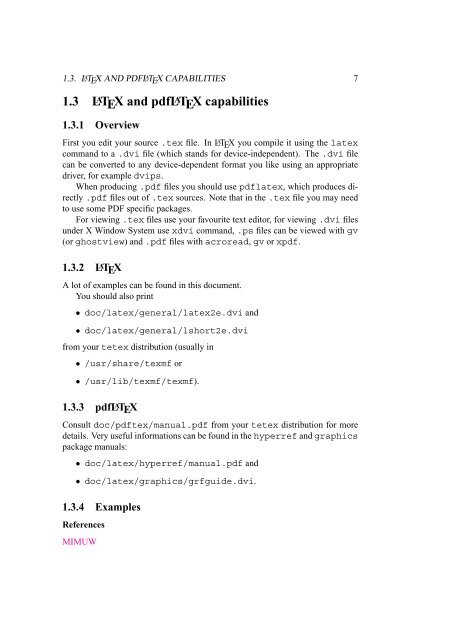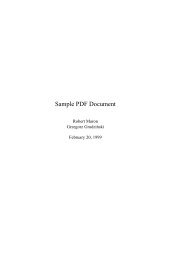Sample PDF Document
Create successful ePaper yourself
Turn your PDF publications into a flip-book with our unique Google optimized e-Paper software.
1.3. L ATEX AND <strong>PDF</strong>L ATEX CAPABILITIES 7<br />
1.3 L ATEX and pdfL ATEX capabilities<br />
1.3.1 Overview<br />
First you edit your source .tex file. In L ATEX you compile it using the latex<br />
command to a .dvi file (which stands for device-independent). The .dvi file<br />
can be converted to any device-dependent format you like using an appropriate<br />
driver, for example dvips.<br />
When producing .pdf files you should use pdflatex, which produces directly<br />
.pdf files out of .tex sources. Note that in the .tex file you may need<br />
to use some <strong>PDF</strong> specific packages.<br />
For viewing .tex files use your favourite text editor, for viewing .dvi files<br />
under X Window System use xdvi command, .ps files can be viewed with gv<br />
(or ghostview) and .pdf files with acroread, gv or xpdf.<br />
1.3.2 L ATEX<br />
A lot of examples can be found in this document.<br />
You should also print<br />
• doc/latex/general/latex2e.dvi and<br />
• doc/latex/general/lshort2e.dvi<br />
from your tetex distribution (usually in<br />
• /usr/share/texmf or<br />
• /usr/lib/texmf/texmf).<br />
1.3.3 pdfL ATEX<br />
Consult doc/pdftex/manual.pdf from your tetex distribution for more<br />
details. Very useful informations can be found in the hyperref and graphics<br />
package manuals:<br />
• doc/latex/hyperref/manual.pdf and<br />
• doc/latex/graphics/grfguide.dvi.<br />
1.3.4 Examples<br />
References<br />
MIMUW



